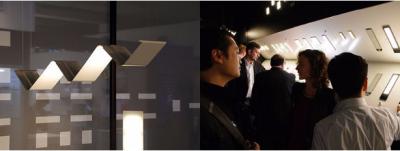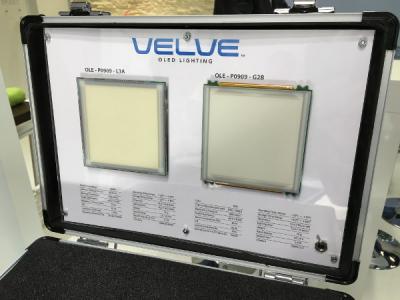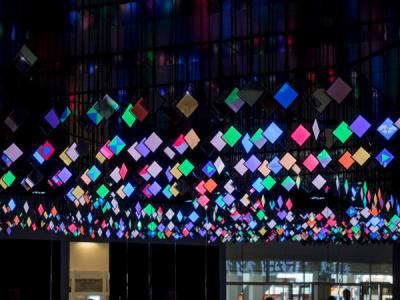The newest developments in OLED technology were eagerly anticipated at this year’s Light and Building show in Frankfurt. Could the latest technical advances and changes to the cost of panel manufacture finally allow the predicated breakthrough into the market?
Light and Building 2016 was host to four OLED Technology manufacturers, all demonstrating the capabilities of their products to an impressed audience.
American OLED-pioneers, OLEDWorks, took over the OLED division from Philips last year. On display were a wide range of products including their impressive Brite FL300 panel family with a luminance of up to 8300 cd/m2 and a luminous flux of 300lm.
 A glimpse at the OLEDWorks presence at L+B 2016
A glimpse at the OLEDWorks presence at L+B 2016
New at this years’ exhibition were Japanese makers, Pioneer, who recently took over the Verbatim range, formerly part of Mitsubishi’s OLED business. Pioneer were exhibiting the only color-tunable OLED module currently on offer on the market. The modules are available in white or RGB, with integrated DMX-controller for seamless color adjustment; a feature that will attract many architects and lighting designers to its wide range of installation possibilities.
 The first commercial demonstrators of Pioneer's color-tunable OLEDs
The first commercial demonstrators of Pioneer's color-tunable OLEDs
Fellow Japanese chemical manufacturer, Sumitomo, were also in attendance demonstrating their OLED printing technology. Their technology will pave the way for the better development of OLED for a mass market. Rather than using the more common vacuum deposition technique, Sumitomo use printing to establish a layered structure within the OLED.
 Installation featuring Sumitomo's coloured OLED panels
Installation featuring Sumitomo's coloured OLED panels
The OLEDs, available both as a panel or as a finished module integrated case, come in variety of colours. As opposed to the variants exhibited at the last Light and Building in 2014, Sumitomo’s new panel generation have improved durability and lifetime.
A particular highlight of the OLEDs on offer was the exhibition stand from LG Display in Hall 6.2. Similar to their previous demonstrations in 2014, LG Display focused on the recent and further development possibilities of OLED. For example, the first commercially available 90lm/W series was on show. Also, the existing wide range of rigid modules on glass substrate is now available on the market with an improved lifetime of L70 from 30-40k h. In addition, LG Display can boast the first commercially ready flexible OLED panel with plastic substrate. The latter are already available with the improved life expectancy of 20,000h (L70), another interesting first!
The brand new fully flexible OLED panel 406x50mm by LGD
The largest fully flexible OLED panel on the market (320x320mm) by LGD
Next to a host of diverse OLED design options and demonstrations, LG Display also presented the Sky and Classic lamps and other completed applications, whose beautiful design and excellent value for money will be attractive for the end use market.
Conclusion: Compared to the dominating LED Technology, OLEDs are still viewed as niche products in the lighting market. Nevertheless, technical developments and hugely improved cost structures are making OLED an ever increasingly attractive source of light.
For further information about any of the products or manufacturers mentioned in this article, or if you have any general questions surrounding OLED, our team at Organic Lights will be happy to help. Contact us at support@organic-lights.com.
Comments
I believe that paradigm shift to OLED lighting will happen much faster than people imagine.
LED might be viewed as a brief, transitional paradigm from incandescent to OLED rather than a lengthy period before the transition which is what seems to the be the operating model and assumption.
Soon, the niche market is likely to be for LED -- as OLED rapidly dominates.
Do you imagine even moderate cost will keep this fantastical realization of lighting from the market?
Even then the cost will probably fall exponentially.


Thanks to the good folks at Organic lights for this. Not everyone gets the allure and grandeur of OLED lighting tech - yet. The benefit of this particular summary is that it allows would be ( hopefully imminent buyers) of OLED lighting wares to get a feel of what each of the firms have to offer. What would be good for us OLED zealots to see; additional shows & industry events showcasing the segments' wares.
What will be transcendent is when we reach the point of OLED lighting tech being so commonplace that an OLED event summary entails information about some of 20 OLED offerings seen at the event.
A last comment - I want to strongly encourage OLED-info.com readers ( everyone really) to go out and buy and USE OLED lighting in your homes and offices... We need to move past discussing & speculating about OLED lighting use; The time is right to actually use them at your place everyday of the week.